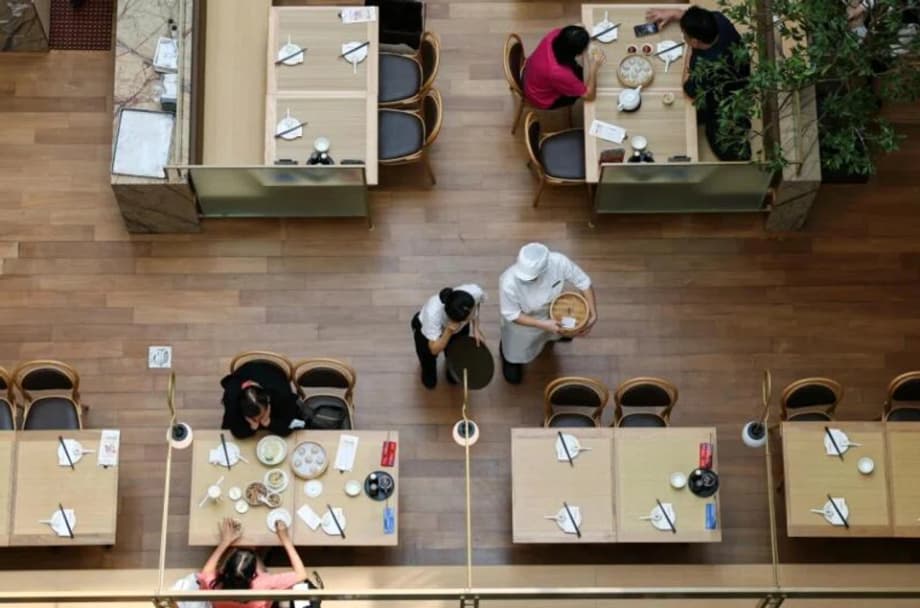A new phase for a crowded dining scene
Singapore’s dining landscape is shifting from speed to precision. After years of rapid rollouts by Chinese hotpot and mass market brands, the city’s restaurant scene is moving into a more selective phase that stresses product quality, operational discipline and sharper concepts. Established Chinese names are tightening execution, while a new wave of entrants, including coffee and tea specialists, arrives with strong backing and finely tuned playbooks. At the same time, global brands from North America and Asia are eyeing Singapore’s cosmopolitan consumers, making the island a proving ground for concepts that can scale across Southeast Asia.
- A new phase for a crowded dining scene
- Why Singapore is the launchpad
- Coffee and tea chains crowd the island
- Efficiency as a competitive weapon
- Landlords, rents and local pushback
- Winners, closures and churn
- Global heavyweights test Singapore
- Tech and loyalty become standard
- Culture and community: inclusion questions
- What it means for consumers
- Key Points
Industry watchers describe this moment not as a ceiling on growth, but as maturation. The first phase rewarded speed, square footage and first mover advantage. The next phase rewards differentiation and staying power. For operators, the questions now are whether their menus stand up to repeat visits, whether stores run lean and fast, and whether brands can hold attention in a market packed with choice.
Why Singapore is the launchpad
Many Chinese F&B operators are expanding abroad after a bruising period at home. Domestic demand has been soft since the end of pandemic restrictions. A long property slump and sustained price competition have squeezed margins, and tariffs have added pressure in other sectors that feed into consumer confidence. This backdrop has fueled a push overseas. Singapore offers cultural familiarity, rule of law, English speaking staff, tech savvy consumers and a central position in Southeast Asia. For investors, an address in the island’s prime malls and business districts is a useful signal. According to consultancy Momentum Works, about 85 Chinese brands operated roughly 405 outlets in Singapore as of August, more than twice the footprint a year earlier.
With that scale has come tension. Some entrants are backed by deep capital and global ambitions, which helps them secure prime space. One example is Michelin starred Yong Fu from Shanghai, which reportedly invested about S$10 million to establish its first Singapore restaurant and set the stage for further growth in London, New York and Paris. For smaller local operators, matching that kind of spending is difficult. Still, many Chinese brands frame Singapore as a stepping stone to the wider region. Joanna Jia, Singapore manager of ChaPanda, a tea chain that began opening stores in July, explained why a foothold here matters before a push into neighboring markets.
Introducing ChaPanda’s Singapore manager Joanna Jia, who has overseen the chain’s initial store openings in the city, she described the brand’s regional goals in clear terms.
“If we can build up our brand in Singapore, the brand awareness can go to Malaysia and Vietnam, even Indonesia.”
That goal reflects a common playbook: land in Singapore, build recognition among residents and travelers, then scale into Malaysia, Thailand, Vietnam and beyond with stronger financial support and tested operations.
Coffee and tea chains crowd the island
The coffee scene underscores how popular Singapore has become as a springboard. Within months, China’s Luckin Coffee opened about 30 outlets, Indonesia’s Kenangan Coffee launched four, Canada’s Tim Hortons opened two, and Taiwan’s Louisa Coffee and Indonesia’s Fore Coffee each opened at least one. Many choose high visibility sites such as Changi Airport Terminal 2, Jewel, Raffles City and Takashimaya. A presence in the city’s flagship locations is not just about foot traffic. It also puts brands in front of international investors and partners who visit and work in the financial hub.
The incumbents remain strong. Starbucks has over 140 stores in Singapore, while The Coffee Bean & Tea Leaf counts more than 70. Homegrown chain Huggs operates around 20 outlets, and there are hundreds of neighborhood coffee shops. Price points vary widely. A cold brew at a global chain can cost more than S$6, while a cup of black coffee at a local kopitiam averages around S$1.20, which keeps value front and center for many consumers.
Pricing and positioning
Chinese beverage brands segment the market with distinct identities. Chagee positions itself as a modern premium tea label, with collaborations tied to Chinese culture and a wellness tilt. Luckin emphasizes convenience with compact stores and strong mobile ordering, often paired with buzzy partnerships to draw younger customers. Mixue targets the mass market with aggressive pricing and broad suburban coverage. Store formats mirror these choices. Premium tea brands seek immersive, upscale settings, convenience driven coffee chains favor smaller pick up stores, and mass market brands blanket residential districts.
These strategies work because store economics are tightly engineered. Outlet sizes, staffing levels, speed of service, and marketing calendars are calibrated to local demand but powered by centralized systems. This is the same machinery that helped these brands scale across China, now tuned for Singapore’s dense urban fabric.
Consumers feel the impact most in breadth of choice and frequency of promotions. Coffee and tea launches tend to come in quick cycles, limited time flavors refresh menu boards, and app driven deals keep baskets moving. That cadence suits a city that thrives on novelty, yet it raises the bar for sustained loyalty, which is where data and customer relationship tools matter.
Efficiency as a competitive weapon
Many Chinese chains bring rigorous operations to bear. At Meow Barbecue in Singapore, teams apply strict time standards for preparing and serving popular items. Restaurants use digital dashboards to track throughput and inventory in real time, and smart equipment shifts repetitive tasks to automation. Beverage lines are designed so staff can produce a customized iced milk tea in seconds using in house machines. Headquarters in China can push updated recipes and promotional assets to stores abroad instantly, which compresses rollout timelines.
Supply chain muscle amplifies these gains. Large brands source ingredients directly through dedicated factories or exclusive agreements, which trims costs and stabilizes quality. The approach helps sustain sharp pricing even in a high cost city. There are limits though. Payment systems, labor rules, and consumer expectations differ across markets. Staff incentives that work in Shenzhen may not translate in Singapore. The best performing entrants adapt their systems, not just their menus, to local conditions.
Landlords, rents and local pushback
Deep pocketed newcomers have intensified competition for prime space. Real estate brokers say investor backed chains can outbid smaller players for sought after sites, which lifts rents in busy districts. That puts pressure on independent operators and long running local concepts that already face higher utilities and staffing costs. The debate is not only about price, but also about whether a surge of look alike concepts crowds out diversity.
In June, Singapore Tenants United for Fairness, a group that represents about 700 business owners, issued a blunt assessment of the challenge facing local small and medium enterprises when negotiating against larger new entrants.
“They are not even in the same stadium.”
The sentiment is widely shared among neighborhood operators. Chinese brands respond that their confidence is built on lean cost models and disciplined execution, not just capital. Property advisors see both sides of the story. There is clear strain for local tenants, yet the new competition is also forcing a step up in store experience, technology adoption and customer service.
For landlords, a mix of strong global names, rising Chinese brands and resilient local operators spreads risk. For consumers, the net effect is more choice, though rising occupancy costs can make it harder for smaller eateries to hold price points without creative menus or higher turnover.
Winners, closures and churn
Churn has always been part of Singapore dining, but the pace since 2024 has been bruising. Well known brands have shut outlets, including several heartland stores for a major hotpot chain and closures in popular Japanese ramen concepts. Restaurateurs report takings are down compared with last year. High rents and utilities, a tight labor market, and changing consumer habits all weigh on margins. Suppliers feel the strain too, with tougher credit and slower orders.
Even so, new concepts continue to open. Operators that succeed tend to offer strong value or an experience that justifies a night out. The coming Rapid Transit System to Johor Bahru could tilt weekend dining patterns, with some Singaporeans crossing the border for lower priced meals. Others see room for cross border partnerships, shared supply lines and joint promotions that benefit both sides.
Global heavyweights test Singapore
Singapore’s diverse customer base and regional visibility attract more than Chinese names. American and Korean quick service brands, including chicken and Mexican concepts and established Korean chains, are among those exploring or piloting in the city. The pitch is simple. If a format can win in Singapore’s malls and business districts, with demanding diners and stiff competition, it stands a better chance in Kuala Lumpur, Bangkok, Jakarta and Manila.
Chinese giants are also adjusting course. One top hotpot operator that missed profit targets amid tougher domestic competition says it will concentrate expansion in established overseas markets, with the United States on the list. From the local side, Singapore’s BreadTalk Group offers a mirror image. The company says international growth is essential to its future, now running close to 700 stores in 14 markets through a mix of owned and franchise outlets. The lesson is similar. Scaling abroad works best when concepts are localized while staying true to brand identity.
For global names, Singapore is a stage. The audience includes not just residents, but also regional tourists, international students and business travelers who carry impressions to their home markets. Strong brand awareness built here can pay dividends in Southeast Asia and beyond.
Tech and loyalty become standard
Behind the storefront, the real contest is for customer data and repeat visits. Singapore based software firms are racing to arm F&B operators with tools that match the digital sophistication of the largest global chains. One platform launched a white label app service that lets restaurants spin up branded mobile apps in days, complete with online ordering, payments, customizable loyalty and customer relationship management. A global Mexican fast casual brand operating in Singapore has already gone live on the system. The value proposition is control. Operators can own their customer relationships, reduce reliance on third party delivery apps and push targeted offers that raise visit frequency and basket size.
David Brunier, founder and chief executive of the app platform, argues that mobile led engagement will underpin every part of the physical dining business.
“The next generation of physical businesses will run on mobile apps and consumer data.”
These capabilities are no longer reserved for a few giants. With transaction based pricing and templates, mid sized brands can build the same digital muscles. In a market where promotions change weekly and competitors open nearby, a direct channel to loyal customers can be a difference maker.
Culture and community: inclusion questions
The influx of new Chinese eateries has changed the feel of many neighborhoods. Dishes like mala, grilled fish from Chongqing, and Yunnan rice noodles are now common across the island. Many residents enjoy the variety. Others worry about losing the personal touch of long running local businesses as older hawker stallholders retire and younger Singaporeans choose other careers. A government scheme to recognize heritage businesses has made a start, yet only a fraction of applicants have been formally recognized so far.
There are practical inclusion issues too. Some new restaurants display menus mainly in Mandarin, which can be a hurdle for non Mandarin speakers, including some Chinese Singaporeans. People with halal dietary needs can find fewer options in districts where pork heavy menus cluster. None of these concerns are insurmountable. Brands that adopt bilingual menus, more inclusive marketing and staffing that reflects the community tend to build wider followings. Integration improves when newcomers learn local rhythms, just as locals make space for new flavors.
What it means for consumers
For diners, the upside is obvious. More choices at different price points, more frequent product launches and sharper execution raise the standard of a night out or a quick coffee run. The trade off is that high rents and rising operating costs can push prices up at some venues. Value remains, especially at hawker centers and neighborhood shops, and competition among beverage chains has kept prices keen for entry level items. Expect continued app driven deals, loyalty perks, limited time flavors and collaborations that tap pop culture to keep lines moving.
Key Points
- Singapore has moved from rapid expansion to a quality focused phase in F&B, with tighter concepts and stronger execution.
- Chinese chains use Singapore as a test bed for global growth amid weak domestic demand and intense price competition at home.
- Momentum Works counts about 85 Chinese brands with roughly 405 outlets in Singapore as of August, more than double a year earlier.
- Coffee and tea chains led the latest wave, with Luckin, Kenangan, Tim Hortons, Louisa and Fore opening stores alongside established players.
- Operational efficiency, automation and direct supply agreements help Chinese brands compete on speed and price.
- Local tenants face pressure on rents and space as investor backed entrants bid for prime sites, sparking pushback from business groups.
- Churn is high, with notable closures since 2024, yet new openings continue as operators pivot to value and experiences.
- Global brands from the United States and Korea are exploring Singapore as a proving ground for Southeast Asia.
- Digital tools for ordering, loyalty and CRM are becoming standard, as operators seek to own customer relationships.
- Cultural inclusion remains a priority, with bilingual menus and diverse hiring helping new arrivals serve broader communities.




